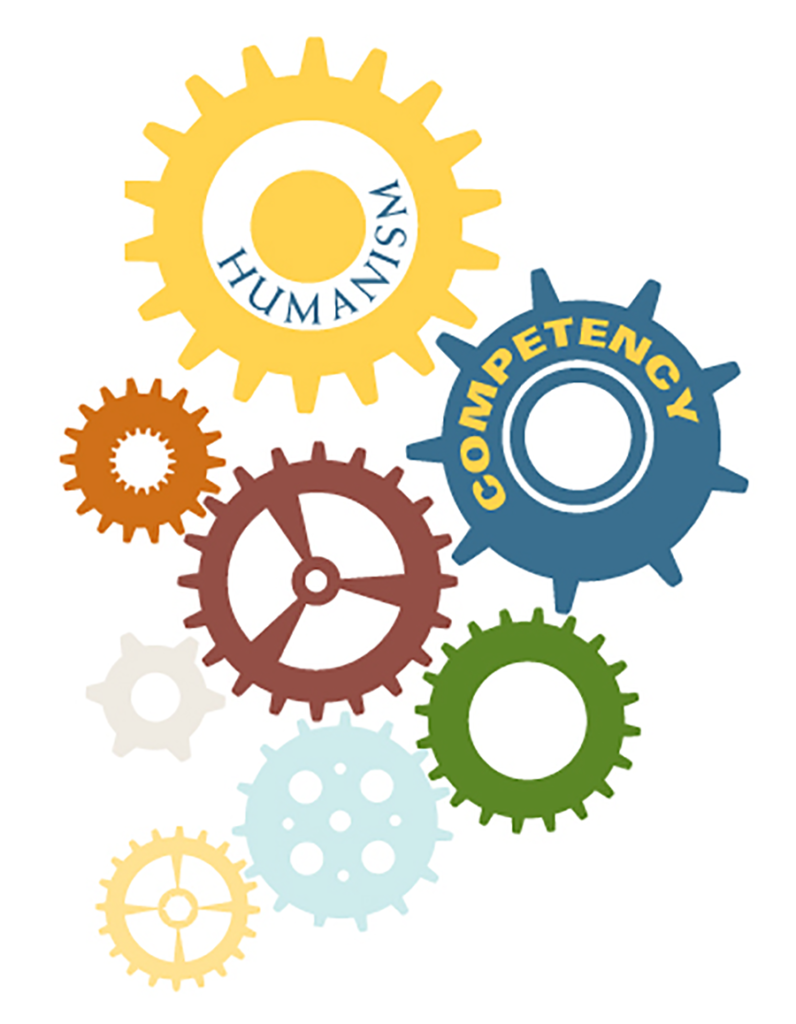By David W. Chambers
Several years ago I met a man who owns a car wash. When he found out where I work, he told me he had once wanted to be a dentist. In fact, he had been a student at P&S when it was on 14th Street. “I didn’t make it,” he said. “It seemed like all the professors wanted to show you how much they knew. And they didn’t mind telling you how little they thought I knew, and they weren’t very kind about how they did it.”
I told him things have changed. He didn’t seem bitter, just disappointed that he missed out on the transformation that former Deans Dale Redig and Arthur A. Dugoni made at Pacific, in dental education generally and in the profession. Our attitude today is “We’re very glad you are here; let’s develop you into a fantastic practitioner!”
The twin cultural changes go by the names of competency and humanism. The first views education as a learner-centered process for producing a professional ready for practice; the second is grounded in a community that respects the dignity and potential of all its members.
Although these sea changes both started at Pacific and have been nurtured here for more than 40 years, they are now standard operating requirements in every dental school in the United States. That is a bold statement, but one that has teeth. In 1997, the Commission on Dental Accreditation adopted standards saying that, “The stated goals of the dental education program MUST be focused on education outcomes and define the competencies needed for graduation, including the preparation of graduates who possess the knowledge, skills and values to begin the practice of general dentistry [Standard 2-4].“ The American Dental Education Association has adopted, by policy, a generic set of competencies; and all dental schools have developed ones that match their unique missions while honoring the core skills, knowledge and values of dental practice. These are not suggestions; all dental schools must operate this way now or they will lose their accreditation.
In July 2013, a new set of accreditation standards will go into effect, maintaining competency and adding humanism. All dental schools will be expected to maintain a “dental school environment characterized by respectful professional relationships between and among faculty and students … that inculcates respect, tolerance, understanding and concern for others.”
Competency
Competencies were introduced to dentistry in a 1993 Journal of Dental Education paper I wrote, called “Toward a Competency-Based Dental Curriculum.” Since then scholarship in this area has accumulated and other professional programs have adopted competency, including nursing, dietetics, business and optometry.
The process began more than a decade before the first paper when then Dean Dale Redig appointed me as director of the Introduction to Comprehensive Patient Care (ICPC) course. This is the Monday, all-day lecture-preclinical-clinical course during the first four quarters that gets students ready for their fast start in clinical care. It was an unconventional move by Redig to put a non-dentist in charge of the second-largest dental course in the program.
But it was critical for competency-based education. There was no way I could make students in my own image: I had to ask “the customers,” the department chairs and clinic administration, what they expected passing students in ICPC to look like.
The deep roots of competency can be traced to Harvard University’s John Carroll who advocated mastery education. No one should be allowed to move on to the next level until they have mastered the preceding steps. Stanford University’s Lee Cronbach also has his fingerprints on the idea. He was fond of saying that the prevailing approach to education was wrong because it standardized the method and expected a distribution of outcomes. He advocated instead that we fix the outcome and vary the methods.
Dr. Arthur A. Dugoni pushed competency-based dental education farther. In 1990, he appointed me as academic dean and made it clear he expected the competency system to be applied to the whole school. Part of the process was the so-called “big bucket” approach. Virtually all 10-hour lecture courses were combined into larger and more multidisciplinary ones. At the time, the policy of the American Association of Dental Schools (the forerunner of ADEA) was based on complete coverage of all that teachers in various disciplines felt comfortable teaching. This amounted to about four feet of curriculum guidelines and an estimated nine-year predoctoral program. The Curriculum Committee adopted a policy that the educational program would only be justified based on what dentists needed for practice rather than what faculty members wanted to teach.
Pacific’s competencies are posted on our website at www.dental.pacific.edu/x1867.xml. If they read a lot like the job description of a practicing general dentist, that is what they are supposed to be.
[pullquote]Although these sea changes both started at Pacific and have been nurtured here for more than 40 years, they are now standard operating requirements in every dental school in the United States.[/pullquote]
Humanism
Humanism is not an educational process like evidence-based dentistry, problem-based learning, technology-assisted education, small-group discussion, vertically-integrated clinics or any other hyphenated methodology. It is a culture. It is who we are. Pacific changed its personality dramatically from the mid-1960s to the mid-1990s. In Dean Redig’s terms, it stopped being a place that tore people down. In Dean Dugoni’s terms, we started to grow people.
When Redig came to Pacific from Iowa in 1969 he found a culture of “toughness.” The College of Physicians and Surgeons was one of the last dental schools to meet the accreditation requirement for integration into a university. There were only a handful of full-time faculty members, and many of the part-time staff were organized into cliques. When William Gies visited P&S to prepare for his now famous Carnegie Foundation report: Dental Education in the United States and Canada, he characterized the school as having a “survivor mentality.” No eyebrows were raised when faculty members berated students in front of their patients. Unsatisfactory lab projects were destroyed on the spot as a kind of public entertainment. Students were dismissed in the middle of a term on nothing more than the suggestion to the dean from a department chair.
All deans until Redig had been insiders (one actually owned the school). The University wanted a change more than the faculty did. But it was obvious that the school’s conditional accreditation status could only be removed by curing the culture. Redig’s response was swift and structural. There were a few meetings, clear guidelines articulated, followed by a period of several months to see who would blink first. New faculty members were brought in to replace those who left. Part-time faculty members were required to take salaries so they could not remain a “fifth column”, and the number of faculty members was increased. Within a few years, a new foundation had been laid by professionalizing the faculty.
Redig had found students somewhat reluctant at first to become beneficiaries of humanism—and also wary of the possibility of getting caught in the middle of the tension between the dean and the faculty, of which they were clearly aware. There were other risks; the old system was more certain: survivors prospered. However, when they fully realized that Redig had meant what he said, and followed through with implementation of new rules and a new way of student, faculty and staff life in the school, they became strong supporters of the positive direction and change that had been put in place.
The second phase in converting Pacific’s culture to humanism was much more gradual and systemic. Dugoni was a product of and understood the old ways at P&S, but he was not sympathetic to its demeaning tendencies. In fact, at one point in his early, part-time teaching career, he had been threatened with immediate firing over his grading practices.
Dugoni focused on the student dimension of humanism. He made students partners in bringing about the humanistic culture. He met with students constantly, in small groups, several-hour meetings that demonstrated his willingness to listen and thus communicate respect, regardless of the details of the conversations. He learned student’s names, and the names of their patients and their children. He was saying, trust first, and then we can do business. It just made sense to Dugoni that students have a unique perspective on their situation and would accept responsibility for their education. The regular evening meetings between student and faculty leaders were notorious for Dugoni’s insisting that the dedicated and most concerned people regarding improving dental education at Pacific were in the room. If they could not make things better no one could.
Dugoni implemented formal changes designed to foster humanism as well. He directed me to lead all department chair searches, about 10 in all, and to oversee the hiring of all full-time faculty members. It was no accident that a criterion in every such search was “understands and respects the unique humanistic culture of Pacific.” That was often the deciding factor in who was hired and who was not. Dugoni also asked me whether anything could be done about student promotion standards. The old system, still used at some schools, involved dismissing students simply based on a low GPA. The new one began there but probed into why performance was below expectation and whether anything could be done to correct it. Contracts were written for students in trouble, requiring tutoring, counseling, diagnostic testing and retesting. Only when attempted remediation failed, or in a few cases, when students declined participation, would students be dismissed or asked to repeat a year.
Both Redig and Dugoni were fond of observing that the way students are treated in dental school shapes the way they will treat their patients, their office team and even their family once they graduate. Between 1995 and 2006, 176 practicing dentists had their licenses disciplined in California. Not one of them was a Pacific graduate.
We were fortunate in the selection and the order of our two previous deans. Redig’s decisive structural changes were needed to pave the way for Dugoni’s more gradual personal touch. The changes they created at Pacific made us all better and are now imitated by every other United States dental school.
I like to think that the fellow who runs the car wash was just the unfortunate victim of bad timing. If his likes were to come into Pacific today there is every reason to believe he would graduate a competent practitioner with a deep sense of worth and dignity.

